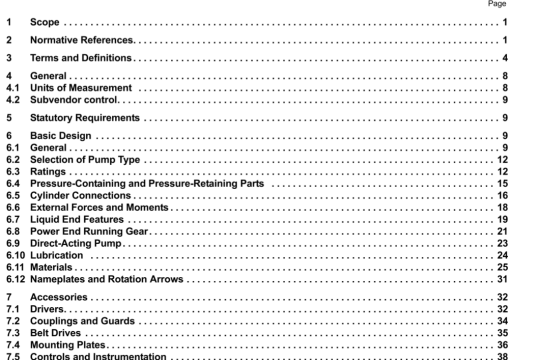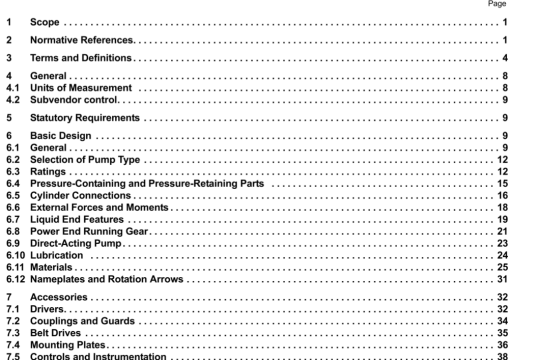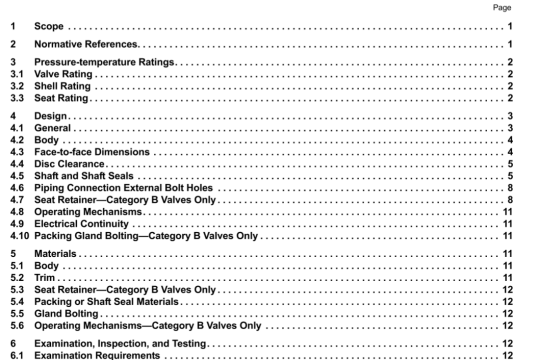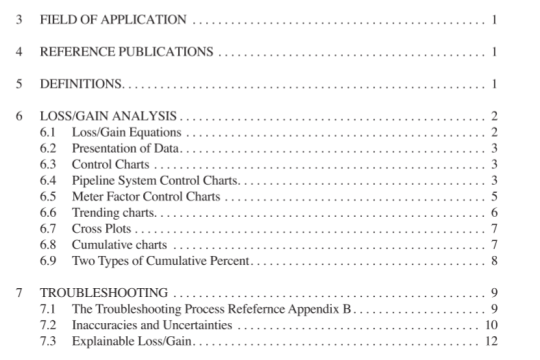API MPMS 4.7:2009 pdf download
API MPMS 4.7:2009 pdf download.Manual of Petroleum Measurement Standards Chapter 4-Proving Systems Section 7—Field Standard Test Measures.
The drain valve shall be a quick-acting full-port valve, open ended for visual inspection, or shall have a visual- inspection device immediately downstream of the valve to detect valve failure. All drain valves shall have the capability of being sealed prior to calibration of the test measure. This valve shall be leak-free at all times. Uniquely numbered seals shall be affixed at the calibration agency with corrosion-resistant stainless steel wire to provide positive proof that the drain valve has not been replaced or serviced since calibration. Minimum drain sizes are described in NIST Handbook 105-3, Table la and Table lb.
Certain flanged type valves are designed to allow replacement of internal parts without affecting the calibrated volume of the test measure. If internal parts are replaced or maintenance is performed on these valve types, the original seal from the calibration agency may be replaced if agreed upon by witnessing parties. This change shall be documented and becomes an additional part of the original calibration report until recalibrated by the appropriate agency.
A test-measure drain is described as a gravity discharge line between the bottom of the bottom cone and the shut-off valve. It shall have a downward slope of at least 50 from the honzontal plane. All pipes connected to the test-measure drain line, downstream of the shut-off valve, shall be positioned at an elevation to ensure the complete emptying of the test measure.
4.5 Levels and Leveling
All bottom-drain test measures that are not in a permanent installation shall have a minimum of three adjustable legs that enable the test measure to be leveled.
All bottom-drain field standard test measures should be equipped with a minimum of two adjustable spirit levels, mounted at right angles to each other, or with equivalent leveling indicator(s) on the upper cone in a protected position on the side of the vessel.
A precision level should be used to verify the permanently mounted spirit levels. If the precision and spirit levels show different level indications, then two vertical level measurements of the neck will be made with a precision level to adjust the test measure to a level position. One of the level indications will be made in line with the neck scale and the other 90° to that indication.
Spirit levels should be verified or adjusted to the vertical neck level measurements prior to shipment to NIST for calibration. Spirit levels are not sealed at NIST.
For all top-drain field standard test measures, the test measure shall be placed on a level flat metal plate for scale readings. The metal plate shall remain level in two perpendicular horizontal orientations during the calibration.
4.6 Scale Plate and Graduations
The scale plate shall be made of corrosion-resistant metal and shall be mounted tangent to the front of the gauge glass. It shall not be more than 0.25 in. (6 mm) from the glass.
Scale numbering on all field standard test measures shall be specified on the scale in milliliters (ml), cubic inches (in.3), or other volume units. The units of measurement should be clearly marked on the scale. To avoid confusion and possible errors in reading, dual numbering on any one scale (e.g. cubic inches and decimal fractions of a gallon) is not permitted. Dual numbering is permitted only if two scale plates are used; in this case, the USC units scale (in.3) is preferred and located on the left when the test measure is viewed from the front.
It is recommended that the metric scale (ml) be installed on the right side of the gauge glass. Provisions shall be made allowing either scale to be adjusted individually so that the two zero lines are in the same vertical position.
Scales shall be graduated both above and below the zero line. For neck sizes smaller than 17 in. (43 cm) in diameter, every fifth line on the scale shall be considered a major division and shall be longer than the intermediate or subdivision lines. Every major line shall be numbered with the volume to that mark. For neck diameters of 17 in.




